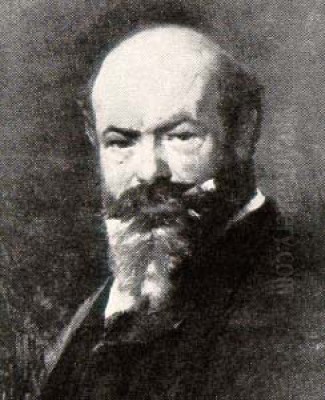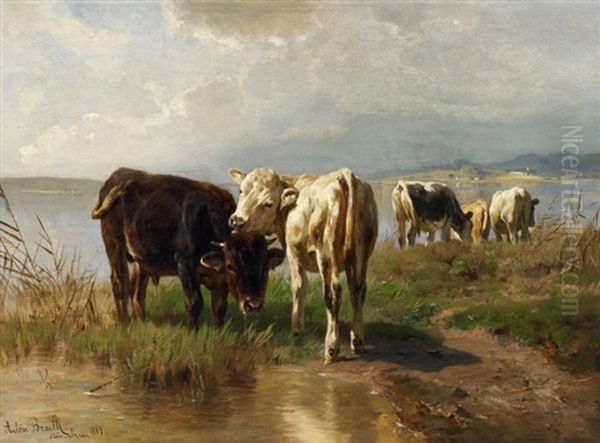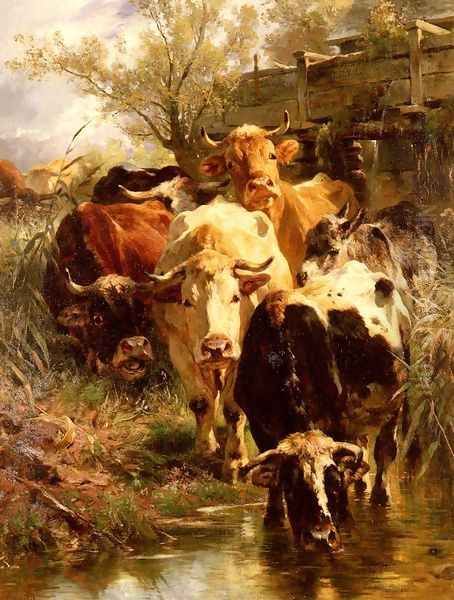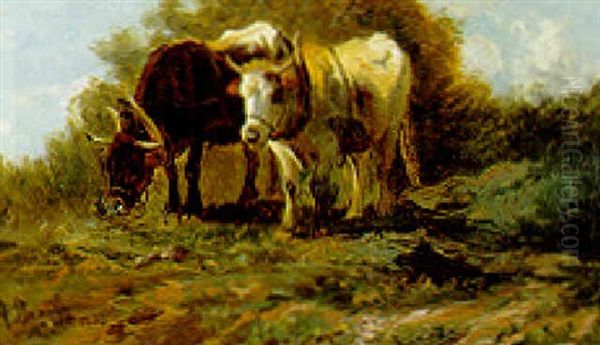
Anton Braith stands as a significant figure in 19th-century German art, celebrated primarily as a master animal painter (Tiere Maler) associated with the influential Munich School. His life (1836-1905) spanned a period of great artistic change, yet he remained largely dedicated to a detailed, realistic style that captured the essence of rural life, particularly the livestock that formed the backbone of the Bavarian landscape. His work is characterized by technical proficiency, keen observation, and a deep empathy for his subjects.
Early Life and Artistic Formation
Born on January 8, 1836, in Biberach an der Riß, a town in the Kingdom of Württemberg (now part of Baden-Württemberg, Germany), Anton Braith showed artistic inclinations early on. His upbringing in a region known for its pastoral beauty likely fostered his interest in nature and animals. The pivotal moment in his artistic development came in 1860 when he moved to Munich, the vibrant artistic capital of Bavaria.
In Munich, Braith enrolled in the prestigious Academy of Fine Arts (Akademie der Bildenden Künste München). This institution was a crucible for the development of the Munich School, a movement characterized by its emphasis on realism, painterly technique, and often, scenes of everyday life, history, or landscape. During his studies, Braith came under the influence of notable artists, particularly the animal and landscape painter Friedrich Volz. Volz's guidance helped shape Braith's early direction, grounding him in the techniques necessary for accurate and compelling animal depiction.
The Development of a Distinctive Style
While initially influenced by Volz, Braith quickly developed his own distinctive artistic voice. His primary focus became the realistic portrayal of domestic animals, especially cattle and sheep, often situated within detailed landscape settings, typically the Alpine foothills or lush pastures of Bavaria. His style is firmly rooted in Realism, marked by meticulous attention to anatomical accuracy, the texture of fur and hide, and the play of light and shadow on his subjects.

Braith possessed an exceptional ability to capture not just the physical likeness of animals but also their characteristic movements, postures, and even perceived temperaments. His paintings often depict herds grazing peacefully, gathered at a watering hole, or being tended by shepherds. He avoided overt sentimentalization, instead striving for an objective yet sympathetic representation of animal life. His use of color was typically rich and naturalistic, contributing to the vividness and immediacy of his scenes.
Beginning in the 1860s, Braith increasingly integrated landscape elements into his compositions, moving beyond simple backdrops to create harmonious scenes where animals and their environment were intrinsically linked. The landscapes themselves were rendered with care, showcasing the specific light and atmosphere of the Bavarian countryside.
Representative Works
Throughout his prolific career, Anton Braith produced numerous paintings that exemplify his skill and thematic focus. Among his most recognized works is Jungvieh am Wasser (Young Cattle by the Water). This painting, likely created sometime between his mature period and his death, showcases his mastery in depicting cattle interacting naturally within a waterside environment, complete with detailed rendering of water, vegetation, and the animals themselves. The work bears his signature and likely a date, common features of his output.
Another key work mentioned is Shepherd with Cattle and Sheep, dated 1886. This title suggests a typical Braith composition, combining human figures (shepherds) with the livestock they tend, set within a pastoral landscape. Such scenes allowed him to explore the relationship between humans, animals, and nature. A similarly titled work, Young Cow by the Water (also dated 1886, possibly another title for Jungvieh am Wasser or a related piece), further underscores his focus on cattle near water sources. Other known titles like Heading for Water and Viehherde an einem Wasser (Cattle Herd by a Water) reinforce this recurring theme. His painting Mountain Cattle Herd, acquired by the Geelong Art Gallery in Australia in 1923, demonstrates the international reach and recognition of his work.
Braith within the Munich School Context
Anton Braith was a central figure within the Munich School during the latter half of the 19th century. This school was not monolithic but encompassed various tendencies, from history painting under Karl von Piloty to the intimate realism of the Leibl Circle (Wilhelm Leibl, Wilhelm Trübner) and the popular genre scenes of Franz Defregger and Eduard Grützner. Braith, alongside his close friend Christian Mali, carved out a niche as leading specialists in animal painting.

The Munich School's emphasis on realism, drawing from observation, and often depicting local Bavarian life provided a fertile ground for Braith's talents. He contributed significantly to the school's reputation, particularly in the genre of animal painting, elevating it beyond mere illustration to a respected form of fine art. His technical skill and dedication to his subject matter earned him considerable respect among his peers and patrons.
Interactions with Contemporary Artists
Braith's position in the Munich art world led to significant interactions with other artists, influencing some and collaborating with others.
His closest artistic relationship was undoubtedly with Christian Mali (1832-1906). Mali, also an animal painter, moved to Munich around the same time as Braith. Braith played a crucial role in guiding Mali towards specializing in animal subjects. They became lifelong friends and collaborators, sharing a deep artistic affinity. Their bond was so strong that they eventually established a joint studio and living space in Biberach, known as the Bathenhaus, which became a local cultural landmark.
Braith also had a significant impact on the younger painter Heinrich von Zügel (1850-1941). Zügel arrived in Munich in the late 1860s and was drawn to animal painting, partly through Braith's example and mentorship. Although Zügel had briefly studied under the history painter Karl von Piloty at the Academy, he found Piloty's approach uncongenial and sought his own path, guided by artists like Braith. A notable collaboration occurred in 1873 when Braith and Zügel jointly created the painting Schafwasch (Sheep Washing), which won recognition at the Vienna World's Fair that year. Braith's influence is visible in Zügel's early work, particularly in technique and the handling of light. Zügel later adopted themes similar to Braith's, such as "Schwere Arbeit" (Hard Work), depicting draft animals, though Zügel would eventually embrace Impressionism more fully than Braith.
As mentioned, Friedrich Volz (1817-1886) was an important early influence and likely a colleague at the Munich Academy. Volz himself was influenced by Dutch masters and Munich contemporaries like the landscape painter Eduard Schleich the Elder (1812-1874) and the beloved Biedermeier genre painter Carl Spitzweg (1808-1885). Braith and Volz shared the distinction of being leading animal painters within the Munich tradition, both contributing to its high standards.

Braith also moved in the circles of other prominent Munich artists. He is noted to have associated with Franz von Lenbach (1836-1904), one of the most famous portrait painters of the era and a dominant figure in Munich's art society. While their specialties differed, their careers overlapped significantly in the city's artistic milieu.
The broader context of Munich animal painting included figures like Albrecht Adam (1786-1862) and his talented sons, Benno Adam (1812-1892), Franz Adam (1815-1886), and Eugen Adam (1817-1880), who specialized in battle scenes, horses, and hunting subjects, establishing a strong tradition upon which Braith and Mali built. While distinct from the intense realism of the Wilhelm Leibl (1844-1900) circle, Braith shared their commitment to observation and truthful depiction, albeit focused on animals rather than Leibl's peasant figures or Wilhelm Trübner's (1851-1917) portraits and still lifes. He was also a contemporary of popular genre painters like Franz Defregger (1835-1921) and Eduard Grützner (1846-1925), whose narrative scenes of Bavarian and monastic life were immensely popular.
Career Highlights, Recognition, and Later Years
Anton Braith achieved considerable success during his lifetime. He became a professor at the Munich Academy of Fine Arts, a prestigious position confirming his standing in the art world. His works were regularly exhibited at major venues, including the Munich Glaspalast annual exhibitions, the Berlin Academy exhibitions, and international expositions in cities like Vienna (where he received awards, possibly in both 1873 and 1883) and Paris.
This exposure brought him international acclaim and patronage. His paintings were sought after by collectors across Europe and beyond. His success allowed him to live comfortably and maintain studios in both Munich and his hometown of Biberach.
In his later career, particularly during the 1880s, Braith showed some interest in the emerging Impressionist movement, which was gaining traction even in the relatively conservative Munich scene, championed by artists like Max Liebermann, Lovis Corinth, and Max Slevogt (though the latter two are slightly later). Some sources suggest a slight loosening of his brushwork or increased attention to atmospheric light effects during this period. However, unlike his protégé Zügel, Braith never fully abandoned his detailed, realistic approach. He remained fundamentally committed to the principles of the Munich School's realism, and his influence began to wane somewhat as newer, more modern styles came to dominate the avant-garde. He did not successfully transition into Impressionism or subsequent movements.
Anecdotes and Controversies
While Braith's career was largely marked by steady success, a few points stand out. His close collaboration and lifelong friendship with Christian Mali is remarkable, culminating in their shared legacy in Biberach. Their joint studio, the Bathenhaus, preserved after their deaths, offers a unique window into the working lives of two successful 19th-century artists.
The slight ambiguity regarding his engagement with Impressionism constitutes a point of discussion. While some sources note an "interest" or a minor shift, others emphasize his failure to adapt. This likely reflects the complex artistic currents of the late 19th century, where established artists grappled with new ways of seeing and painting. Braith's decision to largely adhere to his established realistic style, while perhaps limiting his appeal to proponents of modernism, solidified his reputation as a master within his chosen genre.
His role as a mentor, particularly to Heinrich von Zügel, highlights his importance in fostering the next generation of animal painters, even if his student ultimately pursued a more modern stylistic path.
Legacy, Collections, and Enduring Influence
Anton Braith died in Munich on January 3, 1905. His death was followed shortly by that of his close friend Christian Mali in 1906. In a remarkable act of dedication to their shared artistic life and hometown, Mali bequeathed their combined estates, including the Bathenhaus studio and a vast collection of artworks (Braith's contribution alone included hundreds of oil paintings, numerous sketchbooks, and over a thousand drawings, plus furniture and personal items), to the city of Biberach.
This generous donation formed the foundation of the Braith-Mali Museum (now part of the Museum Biberach). The preserved studio, kept largely as it was during their lifetimes, remains a major attraction and an invaluable resource for understanding 19th-century artistic practice. It stands as a testament to their friendship and dedication to art. The city also planned to erect a monument in Braith's honor, reflecting his status as a celebrated local figure.
Today, Anton Braith's works are held in numerous public collections, primarily in Germany. Key institutions include the Bavarian State Painting Collections (Munich), the Bavarian National Museum (Munich), the Altonaer Museum in Hamburg, and the Museum Biberach. His paintings can also be found in other German museums and occasionally appear in international collections, such as the aforementioned Geelong Art Gallery in Australia.
Academic Evaluation and Modern Perspective
During his lifetime and in the decades following his death, Anton Braith was widely regarded as one of Germany's foremost animal painters. His technical skill, observational acuity, and the sheer quality and consistency of his output were highly praised. He was seen as a pillar of the Munich School and a master of realistic animal depiction.
From a modern art historical perspective, Braith is acknowledged as a significant representative of 19th-century German Realism. His work provides valuable insight into the artistic standards and tastes of the period, as well as documenting aspects of rural Bavarian life. His influence on subsequent animal painters, notably Zügel, is recognized.
However, his adherence to a detailed realistic style means that his work is sometimes viewed as traditional, particularly when compared to the more revolutionary developments of Impressionism and subsequent modernist movements that were emerging during the later part of his career. While technically brilliant, his art may be seen by some critics as lacking the innovative formal experimentation that came to define modern art.
Despite this, his reputation as a master craftsman and a sensitive observer of the animal world remains secure. The preservation of his studio and the dedicated museum in Biberach ensure that his life and work continue to be studied and appreciated. He remains an important figure for understanding the depth and diversity of the Munich School and the rich tradition of animal painting in European art.
Conclusion
Anton Braith was more than just a painter of cows and sheep; he was a dedicated artist who achieved mastery within the demanding tradition of 19th-century Realism. As a leading member of the Munich School, he contributed significantly to the genre of animal painting, capturing the natural world with precision, empathy, and artistic integrity. Through his influential teaching, his collaborations with contemporaries like Christian Mali and Heinrich von Zügel, and his impressive body of work, Braith left an indelible mark on German art. His legacy, carefully preserved in his hometown of Biberach and represented in collections worldwide, continues to offer insight into the art and culture of his time.